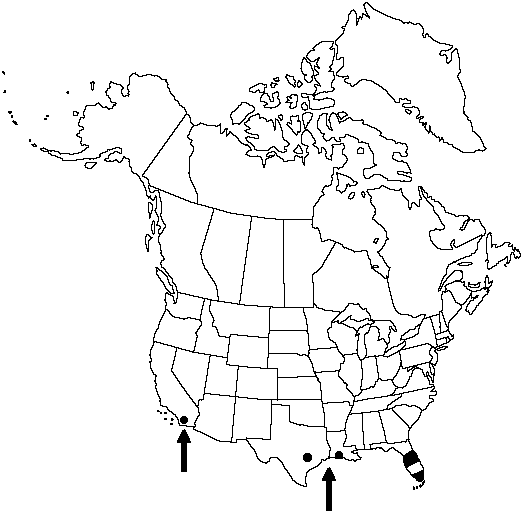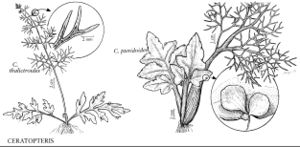Difference between revisions of "Ceratopteris thalictroides"
Bull. Sci. Soc. Philom. Paris sér. 3, 8: 186. 1821.
FNA>Volume Importer |
FNA>Volume Importer |
||
| Line 19: | Line 19: | ||
}}<!-- | }}<!-- | ||
| − | --><span class="statement" id="st- | + | --><span class="statement" id="st-undefined" data-properties=""><b>Plants </b>usually rooted in soil. <b>Sterile</b> leaves lanceolate to lance-ovate to ovate to deltate or cordate. <b>Petiole</b> of sterile leaf 1–31 cm, not inflated. <b>Blade</b> of sterile leaf 1–3-pinnate, 2–41 × 2–20 cm; segments lobed or incised, elliptic to lanceolate to ovate or deltate, to 12.5 cm; proximal pinnae ± alternate. <b>Fertile</b> leaves lanceolate to ovate to deltate or cordate, 2–117 × 2–48 cm. <b>Petiole</b> of fertile leaf 1–46 cm. <b>Blade</b> of fertile leaf 3–4-pinnate proximally, 2-pinnate distally; terminal segments linear. <b>Sporangia</b> usually crowded between segment midvein and revolute margin, with 13–71 indurate annulus cells. <b>Spores</b> 32 per sporangium, 96–124 µm diam. <b>2n</b> = 154, 156.</span><!-- |
-->{{Treatment/Body | -->{{Treatment/Body | ||
| Line 48: | Line 48: | ||
|publication year=1821 | |publication year=1821 | ||
|special status= | |special status= | ||
| − | |source xml=https://jpend@bitbucket.org/aafc-mbb/fna- | + | |source xml=https://jpend@bitbucket.org/aafc-mbb/fna-data-curation.git/src/9216fc802291cd3df363fd52122300479582ede7/coarse_grained_fna_xml/V2/V2_737.xml |
|genus=Ceratopteris | |genus=Ceratopteris | ||
|species=Ceratopteris thalictroides | |species=Ceratopteris thalictroides | ||
| − | |||
| − | |||
| − | |||
| − | |||
| − | |||
| − | |||
| − | |||
| − | |||
| − | |||
| − | |||
| − | |||
| − | |||
| − | |||
| − | |||
| − | |||
| − | |||
| − | |||
| − | |||
| − | |||
| − | |||
| − | |||
| − | |||
}}<!-- | }}<!-- | ||
-->[[Category:Treatment]][[Category:Ceratopteris]] | -->[[Category:Treatment]][[Category:Ceratopteris]] | ||
Revision as of 14:27, 27 July 2019
Plants usually rooted in soil. Sterile leaves lanceolate to lance-ovate to ovate to deltate or cordate. Petiole of sterile leaf 1–31 cm, not inflated. Blade of sterile leaf 1–3-pinnate, 2–41 × 2–20 cm; segments lobed or incised, elliptic to lanceolate to ovate or deltate, to 12.5 cm; proximal pinnae ± alternate. Fertile leaves lanceolate to ovate to deltate or cordate, 2–117 × 2–48 cm. Petiole of fertile leaf 1–46 cm. Blade of fertile leaf 3–4-pinnate proximally, 2-pinnate distally; terminal segments linear. Sporangia usually crowded between segment midvein and revolute margin, with 13–71 indurate annulus cells. Spores 32 per sporangium, 96–124 µm diam. 2n = 154, 156.
Habitat: Aquatic to semiaquatic in swamps, bogs, canals, ponds, lakes, ditches, marshes
Elevation: 0–200 m
Distribution

Calif., Fla., La., Tex., worldwide in tropical areas except Africa.
Discussion
Ceratopteris thalictroides is common in Florida but rare elsewhere. It is tetraploid (n = 77, 78), the two cytotypes reproductively isolated. It can be distinguished from the diploid C. richardii on the basis of spore number per sporangium. The single population in southern California may have been a recent introduction and apparently has not persisted. Several populations are of hybrid origin, with reduced spore viability and irregular meiotic pairing. These include some in southern Florida and Texas.
Selected References
None.
